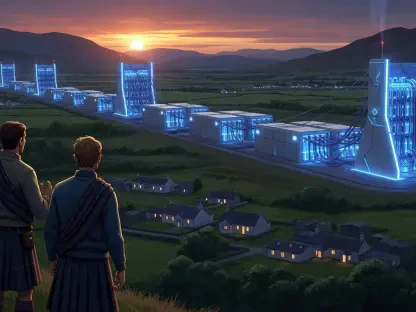The construction industry stands at a critical crossroads in the global fight against climate change, shouldering the burden of a staggering 40% of carbon emissions in the UK and 28% worldwide, as reported by recent industry data. With the deadline to achieve net-zero emissions by 2050 looming, the urgency to shift from traditional practices to sustainable solutions has never been greater. This immense challenge demands more than just good intentions; it requires structured frameworks and actionable strategies to transform ambition into reality. Governance, a key pillar of Environmental, Social, and Governance (ESG) principles, emerges as the linchpin for driving accountability and innovation within the sector. Meanwhile, retrofitting existing buildings offers a practical pathway to significantly reduce emissions. This exploration delves into how governance and retrofit strategies intertwine to steer construction toward a greener, more resilient future, addressing both environmental imperatives and industry demands with clarity and purpose.
Building the Framework for Sustainability
The role of governance in the construction industry cannot be overstated, especially when it comes to embedding sustainability into every layer of decision-making. Often overshadowed by the more visible environmental and social aspects of ESG, governance provides the essential structure for transparency, ethical practices, and accountability. It oversees everything from procurement processes to supply chain management and regulatory compliance, ensuring that sustainability goals are not just empty promises but are supported by consistent, measurable actions. Without this framework, even the most ambitious plans to reduce carbon emissions risk failing due to a lack of direction or follow-through. Governance acts as the bridge between high-level commitments and on-the-ground execution, making it indispensable for aligning the industry with net-zero targets. Its influence ensures that decisions made today prioritize long-term environmental benefits over short-term gains, setting a strong foundation for systemic change across construction practices.
Moreover, governance serves as a safeguard against the pitfalls of greenwashing, where companies might claim environmental progress without meaningful results. By enforcing strict accountability measures, it compels stakeholders to adhere to verifiable standards, fostering trust among investors, regulators, and the public. This structured approach is particularly vital in an industry as complex as construction, where multiple parties—from architects to contractors—must collaborate seamlessly. Governance frameworks help streamline these interactions by clarifying roles and responsibilities, reducing the likelihood of missteps that could undermine sustainability efforts. Additionally, they provide a mechanism to navigate the evolving landscape of regulations, ensuring compliance while anticipating future policy shifts. As the industry grapples with its outsized environmental footprint, governance emerges as the critical tool to transform fragmented efforts into a cohesive, impactful strategy for achieving a sustainable built environment.
Retrofitting for a Greener Tomorrow
Retrofitting, the process of upgrading existing buildings to improve energy efficiency, stands out as a tangible and immediate solution to the construction industry’s carbon challenge, especially in the UK where much of the housing stock ranks among the least efficient in Europe. With millions of structures predating modern energy standards, the need for widespread retrofitting is urgent to meet net-zero goals by 2050. Guided by frameworks like PAS 2035:2023, these projects involve comprehensive energy assessments, ongoing performance monitoring, and post-implementation verification to ensure effectiveness. This thorough approach helps address the inefficiencies inherent in older buildings, reducing energy consumption and emissions without the need for costly new construction. By focusing on what already exists, retrofitting offers a practical way to make significant environmental gains while preserving the cultural and historical value of aging infrastructure.
Beyond its environmental benefits, retrofitting also demonstrates how governance principles can be practically applied to achieve measurable outcomes. Strong oversight ensures that projects avoid shortcuts that might compromise occupant safety or energy savings, addressing common concerns about quality and reliability. Governance mechanisms hold contractors and stakeholders accountable at every stage, from initial design to final execution, guaranteeing that promised reductions in carbon output are actually delivered. This is particularly crucial in a context where the “performance gap”—the discrepancy between intended and actual energy savings—remains a persistent issue. Through structured accountability, governance not only enhances the credibility of retrofit initiatives but also boosts confidence among investors and policymakers who are increasingly prioritizing sustainable investments. As a frontline strategy, retrofitting underscores the power of combining technical solutions with robust oversight to drive the industry closer to its sustainability aspirations.
Navigating the Roadblocks to Retrofit Success
While retrofitting holds immense promise for cutting emissions in the construction sector, its implementation is fraught with significant challenges that can hinder progress if left unaddressed. Skills shortages pose a major barrier, as the specialized expertise required for energy assessments and upgrades is often in short supply, leading to delays and quality concerns. Fragmented supply chains further complicate matters, with inconsistent access to materials and services disrupting project timelines. Additionally, varying standards across regions and a lack of cohesive policy direction create uncertainty for stakeholders, making it difficult to plan and execute retrofit initiatives at scale. These obstacles highlight the complexity of transforming existing building stock into energy-efficient assets, underscoring the need for a coordinated approach to overcome systemic inefficiencies and ensure that environmental goals are not derailed by practical limitations.
Governance emerges as a vital tool to mitigate these challenges, providing a structured framework to instill accountability and streamline operations across the retrofit landscape. By establishing clear guidelines and responsibilities, governance ensures that all parties—from contractors to funding entities—work toward shared objectives with transparency. It helps address skills gaps by promoting training programs and certification standards, while also fostering collaboration to stabilize supply chains through better planning and resource allocation. Furthermore, governance frameworks can advocate for unified policies, reducing the confusion caused by inconsistent regulations and creating a more predictable environment for investment and implementation. This structured oversight is essential to closing the performance gap, ensuring that retrofit projects deliver on their promises rather than falling short due to avoidable errors. Through such measures, governance paves the way for scalable, effective solutions to the industry’s retrofit challenges.
Sparking Innovation Through Structured Oversight
Governance in construction extends far beyond mere compliance, acting as a powerful catalyst for innovation that can reshape the industry’s approach to sustainability. By embedding principles like the circular economy—which emphasizes resource efficiency, reuse, and waste reduction—governance encourages the adoption of forward-thinking practices that minimize environmental impact. It creates an environment where novel materials and methods, such as sustainable insulation or modular upgrades, can be tested and scaled with confidence, knowing that ethical and regulatory boundaries are respected. This structured support is crucial for pushing boundaries without risking reputational or financial fallout, allowing companies to explore cutting-edge solutions while aligning with broader net-zero objectives. As a result, governance transforms sustainability from a checkbox exercise into a driver of competitive advantage and long-term value.
Industry insights, such as those from expert Mark Garry, highlight how governance brings clarity and efficiency to complex decision-making processes, enabling faster progress toward environmental goals. This clarity is especially important when balancing the dual demands of profitability and planetary responsibility, as it helps align business strategies with investor expectations for sustainable returns. Governance frameworks also facilitate partnerships between public and private entities, fostering innovation through shared resources and knowledge exchange. By providing a roadmap for accountability, they ensure that innovative ideas are not just conceptualized but are implemented responsibly and effectively. This dynamic interplay between structure and creativity positions governance as an enabler of transformative change, empowering the construction sector to lead by example in the global push for a low-carbon future through practical and inventive approaches.
Balancing Urgency with Hopeful Action
The construction industry’s substantial contribution to global emissions—accounting for nearly a third worldwide—underscores the critical urgency of achieving net-zero by 2050, a target that demands immediate and sustained action. This pressing timeline leaves little room for complacency, as every delay in adopting sustainable practices amplifies the environmental burden. Yet, amidst this challenge lies a sense of optimism fueled by the potential of governance to turn commitments into concrete results. By providing a backbone of accountability and transparency, governance ensures that the industry’s efforts are not scattered but are directed toward impactful outcomes. This structured approach offers a clear path forward, addressing the sector’s historical inefficiencies while laying the groundwork for a built environment that prioritizes ecological balance over unchecked expansion.
Retrofitting, as a flagship application of governance, exemplifies how targeted strategies can address immediate environmental needs while building momentum for broader change. It tackles the challenge of aging infrastructure head-on, revitalizing existing structures to meet modern energy standards without the carbon cost of new builds. Together, governance and retrofit form a potent combination, merging strategic oversight with practical intervention to create a resilient framework for sustainability. Looking ahead, the industry must continue to leverage these tools, scaling up retrofit programs and refining governance models to adapt to emerging challenges. By investing in skills development, policy coherence, and innovative practices, stakeholders can ensure that the journey to net-zero is not just a distant goal but a tangible reality shaped by today’s decisions and tomorrow’s possibilities.









